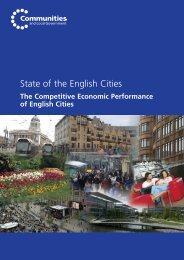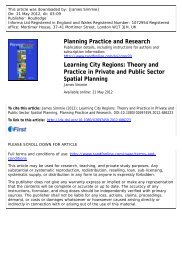History Matters: Path dependence and innovation in British city ...
History Matters: Path dependence and innovation in British city ...
History Matters: Path dependence and innovation in British city ...
Create successful ePaper yourself
Turn your PDF publications into a flip-book with our unique Google optimized e-Paper software.
<strong>in</strong>to new practical <strong>and</strong> commercial forms of<br />
novelty.<br />
1.4 Outl<strong>in</strong>e of the study<br />
In order to <strong>in</strong>vestigate these arguments<br />
empirically we used a sample frame of all<br />
63 <strong>city</strong>-regions <strong>in</strong> Great Brita<strong>in</strong> with core<br />
populations of 125,000 or more. These are<br />
shown <strong>in</strong> Map 1. We analysed their recent<br />
<strong>in</strong>novative performance on the basis of the<br />
results of the Fourth Community Innovation<br />
Survey (CIS4) cover<strong>in</strong>g the period 2002-2004.<br />
We contrasted cities based on this data <strong>and</strong><br />
selected a sample of six of the most <strong>in</strong>novative<br />
<strong>and</strong> six of the least <strong>in</strong>novative cities <strong>in</strong> Great<br />
Brita<strong>in</strong> for detailed analysis. We then collected<br />
long-term secondary data for these 12 cities<br />
to illustrate the relationships between their<br />
sectoral development pathways <strong>and</strong> the<br />
absorptive capacities <strong>and</strong> <strong><strong>in</strong>novation</strong> underly<strong>in</strong>g<br />
<strong>and</strong> driv<strong>in</strong>g them. We selected two of the most<br />
contrast<strong>in</strong>g cities, Cambridge <strong>and</strong> Swansea, for<br />
more detailed historical analysis.<br />
Our task is to expla<strong>in</strong> the long-run divergence<br />
of <strong>city</strong>-regional economies <strong>in</strong> Brita<strong>in</strong>. Our<br />
approach is to adopt an analysis based on<br />
the theoretical concepts of evolutionary path<br />
<strong>dependence</strong>. We argue that this is appropriate<br />
because it focuses on the dynamics underly<strong>in</strong>g<br />
the long-run structural changes <strong>in</strong> spatial<br />
economies.<br />
We argue that local <strong><strong>in</strong>novation</strong> systems are<br />
the key driv<strong>in</strong>g mechanism underly<strong>in</strong>g change<br />
<strong>in</strong> spatial economies because they are the<br />
primary source of new commercially valuable<br />
knowledge. Indeed, their ma<strong>in</strong> functions are<br />
the creation, adoption <strong>and</strong> commercialisation<br />
of such knowledge. It has also become, along<br />
with l<strong>and</strong>, capital <strong>and</strong> labour, a key factor of<br />
modern economic production.<br />
Underly<strong>in</strong>g the ability to <strong>in</strong>novate is the<br />
collective absorptive capa<strong>city</strong> of the firms,<br />
<strong>in</strong>stitutions <strong>and</strong> organisations located <strong>in</strong> a<br />
particular <strong>city</strong>. This provides the asset base for<br />
the identification, assimilation <strong>and</strong> exploitation<br />
of new knowledge. This capa<strong>city</strong> is itself<br />
path dependent on the dist<strong>in</strong>ctive structures<br />
<strong>and</strong> pathways that emerge <strong>in</strong> specific urban<br />
economies.<br />
18













